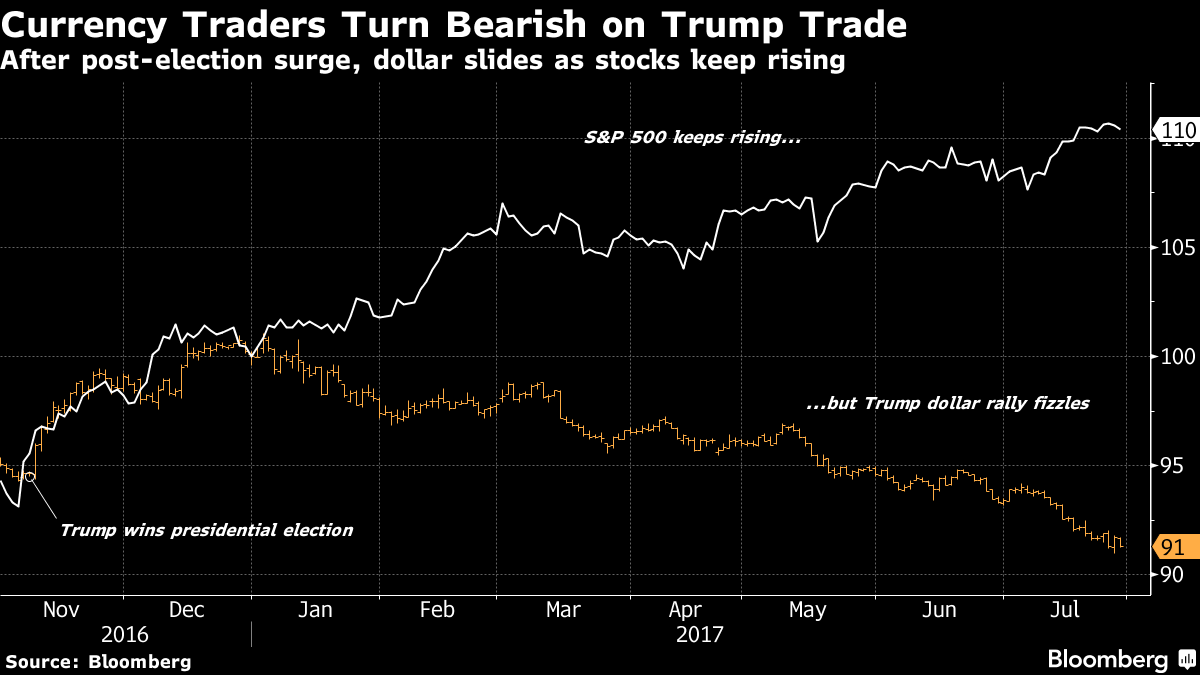President Donald Trump loves to trumpet the record run in U.S.stocks.
|“Stock market hits another high with spirit and enthusiasm sopositive,” he tweeted on July 12, in one of eight posts about themarket this month.
|But he's hardly tweeted a word about another, less rosy measureof Trump's America: the U.S. dollar. The greenback has fallen hardon his watch and currency traders are now betting on even moredeclines.
|Is Trump necessarily “bad” for the dollar, that global symbol ofU.S. economic might? Probably no more than he is “good” for stocks.And you can argue much of the dollar's slide—now the longest in sixyears—has to do with the vagaries of central-bank policy andinterest rates. But more and more, it's the political drama inWashington that is taking center stage. And there's no better placefor investors to express their views about how a nation is managingits affairs than the $5.1 trillion-a-day global market for foreignexchange.
|“The beauty of currency is that it's a relative price,” saidShahab Jalinoos, Credit Suisse's head of global FX strategy. “Ittells you how a country is perceived relative to every othercountry.”
|Currencies, the medium of exchange that affects all otherprices, have traditionally been the purest play on a country'soutlook, whether economic or political. The relationship has onlygrown stronger in an era of quantitative easing, which hasdistorted the bond and stock markets. And with centralbanks around the world pushing interest rates to rock-bottomlevels, rate differentials are far narrower than they used to be,which has helped make currency traders more attuned to politicaldevelopments.
|“What's most interesting is the way that so many policydecisions and risk events get played out through currency marketsthese days,” said Mark Haefele, the global chief investment officerat UBS Wealth Management, which oversees more than $2 trillion.
|To be fair, the dollar has also come under pressure fromlackluster economic data, which weakened the case for higherinterest rates in the U.S. as central banks elsewhere move totighten. And Trump, on more than one occasion, has talked aboutwanting a weaker dollar and complained that its strength is anegative for U.S. manufacturing—a key part of his “America First”agenda.
|Yet even here, going against America's longstanding “strongdollar” policy so publicly could backfire, according to John W.Snow, who served as Treasury secretary under President George W.Bush.
|“You don't want to add to the volatility,” said Snow, now thechairman of Cerberus Capital Management. “It's a criticallyimportant market.”
|“The currency reflects what is going on in a country and theexpectations for that country's growth and prosperity and inflationand interest rates,” he said.
|At first, currency traders, like their counterparts in the stockmarket, embraced Trump's election and bought into his pro-growthpromises of lower taxes and higher infrastructure spending. Thedollar soared in November before ending the year at the highestsince at least 2005, according to the Bloomberg Dollar Spot Index,which tracks the greenback versus 10 global currencies.
Unforced Errors
Since then, things have unraveled. While the stock market hasrallied to new highs as equity investors looked past politics andfocused on corporate earnings, the dollar has slumped more than 8%,wiping out the post-election bump and then some. To many, itreflects deepening worries the turmoil embroiling Washington—muchof which has been Trump's own making—is undermining his ambitiouseconomic agenda.
|And as his administration has lurched from one crisis to thenext—from the firing of FBI Director James Comey toallegations of collusion with Russia and the Republican Party'sfailure to repeal Obamacare—something of a consensus has emerged inthe currency market. And that's to sell the dollar.
|“Look at how the dollar moved up when it was felt that the Trumpelection was going to lead to happy days again,” Snow said. Now,“it looks like the administration's ability to get things done,like infrastructure spending and tax reform and health-care reform,are not being realized.”
|Take July 20, for instance, when news hit that an investigationof the Trump campaign's ties to Russia expanded to his financialdealings. The dollar immediately sank to an 11-month low. Just twodays earlier, the currency slumped after a Republican effort tooverhaul health care broke down.
|UBS's Haefele is a dollar bear himself. His favorite trade is tobet on the euro rising against the greenback, and he sees thecommon currency potentially reaching $1.20 within the next 12months from about $1.173 today. That's a stunning turnabout fromthe start of the year, when the seemingly unstoppable dollar pushedthe euro to 14-year low of $1.0341.
|He's hardly alone. Hedge funds are piling into bearish bets onthe dollar, and now have the biggest net short position in fouryears. The median year-end forecast for the greenback has fallen to$1.14 per euro, the lowest since 2015.
|“We're going to see continued weakness in the dollar,” saidKristina Hooper, the global market strategist at Invesco. “It isvery much a vote of confidence, or lack of confidence, in the U.S.economy.”
|
Copyright 2018 Bloomberg. All rightsreserved. This material may not be published, broadcast, rewritten,or redistributed.
Complete your profile to continue reading and get FREE access to Treasury & Risk, part of your ALM digital membership.
Your access to unlimited Treasury & Risk content isn’t changing.
Once you are an ALM digital member, you’ll receive:
- Critical Treasury & Risk information including in-depth analysis of treasury and finance best practices, case studies with corporate innovators, informative newsletters, educational webcasts and videos, and resources from industry leaders.
- Exclusive discounts on ALM and Treasury & Risk events.
- Access to other award-winning ALM websites including PropertyCasualty360.com and Law.com.
*May exclude premium content
Already have an account? Sign In
© 2024 ALM Global, LLC, All Rights Reserved. Request academic re-use from www.copyright.com. All other uses, submit a request to [email protected]. For more information visit Asset & Logo Licensing.







